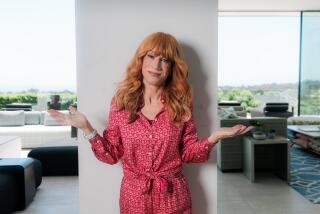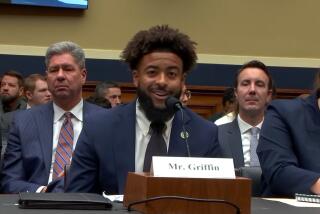The Merv in the mirror
- Share via
Merv Griffin ambles through the lobby of his Beverly Hilton Hotel, his publicist, company vice president and beloved Shar-Pei in tow. He greets staff by name and cracks one-liners, seemingly unfazed by a power outage that has left the hotel without electricity for much of the day. This tour is an opportunity for Griffin to reminisce in an easy way about his career; as he strolls its well-appointed hallways and vast gathering spaces, he gestures grandly, aware that he’s being studied.
Seventeen years after leaving his groundbreaking television talk show for a career as an entrepreneur, Griffin is still charismatic and camera-ready -- cornflower blue sport coat and white pants, ultra-bright smile and year-round tan. He says he enjoys hotel living because it’s “terribly convenient” and gives him the opportunity to “meet the audience,” but a few minutes later he gripes that “everybody is on top of you. You never have any private time.”
Griffin has hinted that the hotel is on the block. “It’s a strong possibility,” he says but won’t go further. (A hospitality industry analyst who asked not to be identified said that negotiations appear to be underway with a potential buyer.)
In the lobby, Griffin chats with Jimmy Goldsmith, son of the late Anglo-French billionaire James Goldsmith. Moving on, he notes sotto voce of the elder Goldsmith, “Ooh! Jimmy, he could affect the economies of nations!”
Griffin’s own fortune and influence are vast, spanning the worlds of hospitality, real estate, entertainment and gaming. The Los Angeles Business Journal recently ranked him as one of the city’s richest denizens, with a net worth of $1.2 billion.
Griffin winters at his 240-acre La Quinta thoroughbred ranch, often flying there in his Challenger jet. He summers at his 57-acre vineyard in Carmel Valley. He also has an 18th century manor in Ireland, St. Clerans, once owned by John Huston and now an inn.
But at 77, Griffin hasn’t relinquished the limelight. He’s still recording -- his most recent album, “It’s Like a Dream,” was released in 2001 (on Pat Boone’s Gold Label). And tonight, Griffin’s lifelong work as a songwriter, composer, recording artist and producer will be honored by BMI at the performing rights organization’s Film and Television Songwriters and Composers Awards in Beverly Hills. From the looks of it, Griffin’s new autobiography, “Merv: Making the Good Life Last” (Simon & Schuster), is aptly titled.
But there’s one word that clouds Griffin’s sunny, self-deprecating mood. “Retirement is death,” he says. “Oh. I wouldn’t want to do that.”
Merv Griffin is gregarious and warm, and as his old friend Larry King says, “very reachable for a magnate.” He possesses a razor-sharp wit that borders on sarcasm, and an appetite for gossip. During the two-hour tour, however, he keeps his private life out of reach, and his conversation often circles back to a more comfortable realm: his more than three decades as a TV show host.
He professes to be embarrassed by his fortune, but is said to drive a mean bargain. “I’m just not intimidated,” he says. In his memoir, he details his business dealings with great pride, devoting an entire chapter to his successful fight to outbid Donald Trump for the Atlantic City-based Resorts International casino company. “I imagine if you were in on a deal with him, he’d hammer you pretty good,” says King. “Or he has people who do that pretty well.”
Griffin acquired a large part of his fortune in 1986 when he sold two shows he created -- “Wheel of Fortune” and “Jeopardy!” -- to Coca-Cola’s Columbia Pictures Television unit for $250 million. In the 1990s, he bought and sold 14 hotels and was briefly involved in riverboat casino gambling in Louisiana and Illinois. Still, when it comes to talking about his wealth, Griffin can be coy. During his recent book tour, he told talk show host Bill O’Reilly: “I don’t care about money.”
Images of the old days
In the hotel’s ballroom, Griffin’s dog, Charlie, strains against his leash and rhinestone collar (a gift from Burt Bacharach). “You can take him off, Ronnie,” he says to Griffin Group Vice President Ron Ward. “It’s his hotel.” Charlie sprints away, leaving his owner in the center of a dark, vacant space with tables and chairs scattered where the cleaning crews left them after Cardinal Roger Mahony and a thousand guests dispersed the night before. “Andy Garcia was a ballroom waiter here,” he says later.
Outside the ballroom, images of his talk show days line nearly every corridor of the hotel. Each photo depicts a younger, slimmer Griffin. There’s Richard Burton and Griffin on a California hillside. There’s a windblown Griffin lunching in Monaco with Princess Grace. “There’s Ronnie and Nancy when he was the governor,” says Griffin. And, of course, photos from the set of “The Merv Griffin Show”: Steve Martin, Jerry Seinfeld, Jay Leno.
Griffin was a pioneer of the modern talk show format who, by his own account, refused to bow to network censorship.
He recounts in his book how stripper Gypsy Rose Lee dropped her drawers on live television in the early ‘60s. Abbie Hoffman appeared on the show in 1970, wearing his famous flag shirt, a month after his involvement in disrupting the 1968 Democratic National Convention. Griffin was the first to interview former Vice President Spiro Agnew after his 1973 resignation over income tax evasion charges. And in the mid-1970s, Christine Jorgensen, the first man to successfully undergo a sex change, shared her experience with Griffin.
“One of the most satisfying aspects of doing my show was that I was sometimes able to open a window for people that allowed them to reexamine their own prejudices,” he writes. At the end of a long hallway, Griffin steps onto a balcony overlooking the Olympic-size pool and lights up a cigarette.
“I love the kid at night -- Craig Kilborn,” he says, taking a drag. “I think he’s very bright....And I love this new kid -- Jon Stewart. Jon Stewart’s got it all. He’s got the young handsome looks and yet very intelligent humor and quick response.”
He enjoys on-air interviews, he says, despite the format changes that “took away all the great storytellers.”
“The two things that hurt talk shows the most was when they took off the restrictions on the number of commercials -- so you can have commercials every five minutes,” says Griffin. “The other thing was the remote control buttons. [Today] they can literally sit there and click your life away.”
When asked whether he watched his own recent interviews when they aired, he grows quiet. “No,” he says. “I don’t usually watch them. I identify with the face on the walls downstairs. But I don’t know the new face.” Despite Griffin’s dishy nature, he’s reserved about his personal life. His divorce, his enduring relationship with Eva Gabor and a battle with cancer warrant the fewest words in his memoir. “When something’s over, it’s over,” he says. “Turn the page.”
His 17-year marriage to Julann Wright, with whom he had a son, is handled in about three pages. Gabor became famously close after his 1972 divorce and remained so until her death in 1995. “The reason Eva and I never got married,” he writes, “was because I couldn’t forget something Julann said soon after our divorce: ‘I married my best friend and it was the end of a beautiful friendship.’ ”
Diagnosed with prostate cancer in 1996, Griffin took off for two months on his yacht, returned home for seven weeks of radiation therapy, and has been fine ever since. The treatment, he writes “was surprisingly easy.”
Personal space
The tour ends in Griffin’s office, a modest-sized room on the sixth floor dominated by a giant redwood desk. (Griffin’s two-bedroom apartment is just around the corner, but off limits.)
Another wall of photos shows Griffin with several American presidents and icons. “I had one of the only sit-down interviews with Martin Luther King,” he says. And as for John F. Kennedy, he adds, “I emceed his last party before he was shot.”
He motions to more than a dozen Emmys on a shelf behind his desk. “They’re everywhere,” he says. “Some of them are even lamps now.”
Griffin settles into his leather chair and when prompted shares his interviewing techniques, which he says once earned high praise from Sigmund Freud’s last student: Look people in the eye. Ask interesting questions. Don’t get too personal.
Indeed.
*
Times staff writers Ann Conway and Roger Vincent contributed to this report
More to Read
Inside the business of entertainment
The Wide Shot brings you news, analysis and insights on everything from streaming wars to production — and what it all means for the future.
You may occasionally receive promotional content from the Los Angeles Times.









